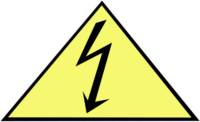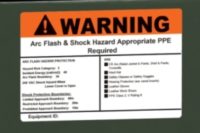Human error - unsafe work procedures, maintenance mistakes, and mishandling tools, wires, and metal covers;
Negligent preventive maintenance - not checking for loose termination, allowing dust and debris build-up (critical in medium voltages and higher), and not testing stored energy (e.g., spring-operated bolted pressure switches); and
Improper electrical equipment/system design - incorrect modifications or using legacy equipment that doesn’t meet current arc flash standards.
These create numerous opportunities to cause a flash and just as many opportunities to misunderstand how to prevent it. Here is a list of fallacies that persist:
1. Arc flash explosions do not happen… I have never seen one!
2. NFPA-70E is the standard governing arc flash – It’s really about reducing live work by de-energizing a circuit first and putting it in an electrically safe condition before starting to work.
3. AFH labeling equals compliance with NFPA-70E - To work on any energized equipment above 50 volts, an energized work permit is required. 70E warns qualified workers of potential danger — it doesn’t give anyone authority or consent to work on energized equipment simply because he or she has complied with the PPE requirements label.
4. Arc flash analysis is simply panel labeling - Arc flash analysis is about hazard reduction. It is not merely PPE or wardrobe selection.
5. Assessing equipment under 240 volts from a transformer rated below 125 kVA isn’t necessary - OSHA regulations and NFPA-70E standards mandate all equipment operating at 50 volts and higher must be tested for electrical shock and potential AFH.
6. Regular infrared scans of equipment rule out doing an arc flash analysis - Arc flash can be caused by equipment failure or loose connections, but most injuries are caused by human error and will only be avoided through regular analysis of equipment, work practices, and safety training programs.
7. Beyond the Motor Control Center (MCC), it isn’t necessary to check equipment for AFH - Just because the MCC is the final access point of power for motor loads, doesn’t mean there isn’t a need to assess other loads, which are fed from it.
8. Current-limiting fuses reduce most AFH – These don’t thoroughly address the duration component of arc flash. A current-limiting fuse will mitigate AFH only if the fault current is high enough.
9. There's no AFH if there's no exposed, energized conductors or circuit parts – For most equipment, the probability of an arc flash may be very low, but it’s certainly not impossible. Inserting or removing draw-out circuit breakers, bus plugs and MCC buckets can cause an arc flash where, normally, is no perceived hazard — “normally” operating electrical equipment has been known to fail.
10. Downstream arc flash hazards are always less violent than upstream arc flash hazards – run a full assessment, up and downstream.
Source: DataCenterKnowledge www.datacenterknowledge.com



